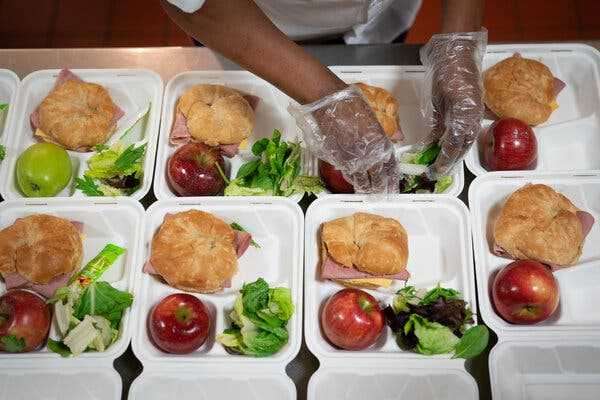The bipartisan bill passed as pandemic-era waivers, including a provision that offers free meals to all children, were about to lapse.
-
Send any friend a story
As a subscriber, you have “>10 gift articles to give each month. Anyone can read what you share.
Give this article
- Read in app

A cafeteria worker preparing lunches at an elementary school in Baltimore. The approval of the legislation was a rare instance of Congress extending a pandemic assistance program.
WASHINGTON — The House passed legislation on Friday to extend free meals and other food assistance for children, clearing it for President Biden’s signature one week before a series of pandemic-era waivers was set to expire.
The bipartisan bill, which passed the Senate on Thursday night by unanimous consent, was a compromise that will prevent children from going hungry, creating a lifeline for families beleaguered by inflation and supply chain woes. It was a rare instance of Congress extending a pandemic assistance program, coming as the Biden administration’s requests for additional coronavirus aid have stalled amid Republican opposition.
The legislation, the Keep Kids Fed Act, which the House approved on a voice vote, extends meal reimbursements and policies aimed at providing more flexibility for schools and meal operators through the summer and the next school year. The measure extends free meals for all children, which had been scheduled to lapse on June 30, until the end of the summer.
Congress also authorized the Agriculture Department during the pandemic to reimburse school districts for those meals at higher rates. The legislation passed on Friday reduces those reimbursements — providing school districts with an additional 40-cent reimbursement for lunches and an additional 15-cent reimbursement for breakfasts above baseline levels — but still reflects a higher rate than before the pandemic.
It also extends pandemic-era measures that gave food providers more flexibility, such as allowing meals to be served outside of school cafeterias or to be brought home by students, and relaxing nutrition standards when healthier food options are unavailable, which is meant to provide relief amid supply shortages.
The House initially passed a more generous version of the bill that would have extended free meals into the coming school year for any student who qualified for reduced-priced meals, but it was scaled back to revert to previous income requirements for reduced-price and free meals for the next school year because of Republican opposition in the Senate.
“I’m glad that leaders on both sides of the aisle came together to reach this agreement and avert a hunger cliff which would have left countless of our most vulnerable children and families without access to food this summer and into the school year,” said Representative Jim McGovern, Democrat of Massachusetts. “Over the summer, hunger gets worse because kids don’t have access to reliable breakfasts and lunches at school.”
Still, some worry that the bill’s late arrival and limited scope will leave schools financially and logistically strapped and many students hungry as families continue to face food price increases and schools struggle to source ingredients.
Under the pandemic waivers, roughly 30 million children received a free school lunch in the 2021-22 school year, a spokeswoman for the Agriculture Department said.
Just how many students will receive a free school lunch in the upcoming school year is difficult to predict. Before the pandemic, about 20 million children received a free school lunch and another two million paid for a reduced-price lunch. School nutritionists and advocates worry about children whose families make slightly too much to qualify for free meals or whose parents remain unaware of the new guidelines.
“For two and a half years, families haven’t had to fill out an application,” said Lisa Davis, the senior vice president for the No Kid Hungry campaign, an anti-hunger effort by the nonprofit Share Our Strength. “Now all of a sudden they will, and there’s not a lot of time to communicate with them.”
“I think what we’ll see when the school year starts,” she added, “is that there are a lot of eligible people who haven’t heard things are changing over.”
Source: nytimes.com



